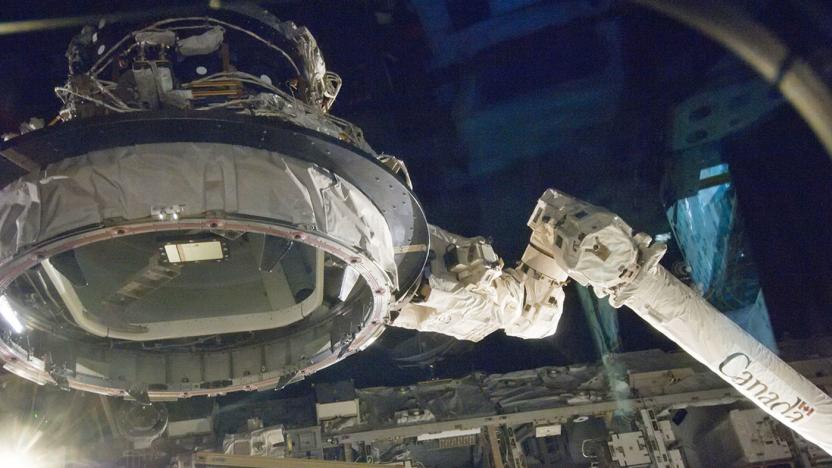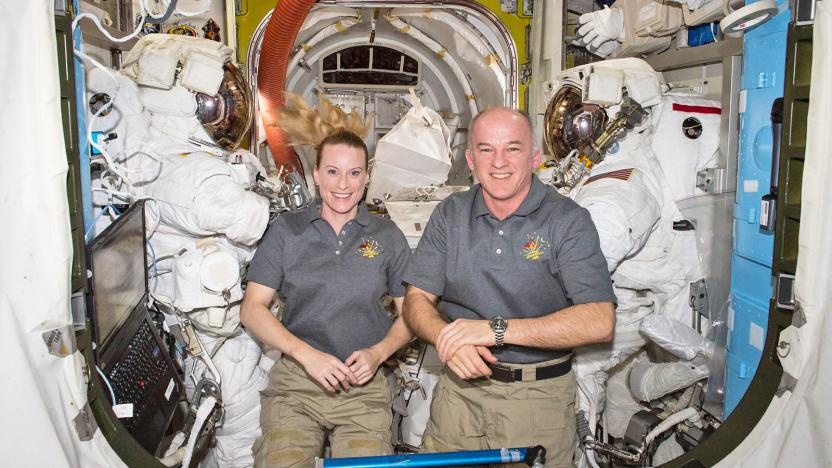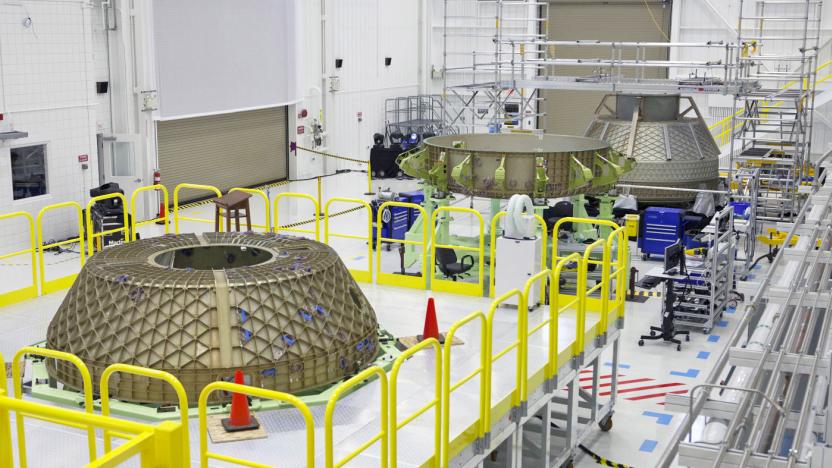spacetaxi
Latest

The new space race is postponed until 2018
Aboard the International Space Station, an A4-size flag of the United States hangs next to a 1:100 model of a space shuttle. The memento, placed there by the last crew to fly on shuttle Atlantis, is meant to be retrieved by the next batch of astronauts that launches on a US spacecraft. NASA had hoped to reach that goal in 2017 after awarding Boeing and SpaceX billion-dollar contracts under the Commercial Crew Program (CCP). However, the road back to manned missions is paved with thorns and technical challenges. We certainly won't see any astronauts ferried to Low Earth Orbit before the year ends, but both companies believe that 2018 is the year that flag will be returned to Earth.

Sierra Nevada spacecraft completes first test flight in 4 years
If Sierra Nevada is going to fulfill supply missions for the International Space Station and the UN, it'll have to prove that its Dream Chaser spacecraft is ready to fly... and it just took a big step in that direction. The company has revealed that Dream Chaser completed a glide test flight on November 11th, launching from a helicopter and landing at California's Edwards Air Force Base. Notably, it's this vehicle's first flight in 4 years, and its first successful landing demonstration -- when this ship last flew in 2013, stuck landing gear forced a rough touchdown.

NASA prepares the ISS for its second space taxi dock
NASA has begun preparing the ISS' second space taxi dock for Boeing's CST-100 Starliner and SpaceX's Crew Dragon. Flight controllers at NASA Johnson Space Center have taken control of the station's robotic arm, the Canadarm 2, to relocate one of its Space Shuttle-era docking modules. To prepare for the move on March 26th, two crew members conducted a spacewalk to detach the power and data cables connecting the module to its old location. Now, it's placed right next to the first dock astronauts installed last year.

Boeing's Starliner space taxi will have over 600 3D-printed parts
Boeing may have pushed the Starliner's first trip to the ISS back to 2018, but we're sure to get more details about the space taxi between now and then. Reuters reports the spacecraft will pack more than 600 3D-printed parts thanks to Boeing's recent deal with Oxford Performance Materials. Printed with a plastic called PEKK, the parts are expected to perform well under the stress of spaceflight and extreme temperatures.

Boeing pushes space taxi's first ISS mission to late 2018
Boeing's CS-100 Starliner won't be ferrying astronauts to the ISS until December 2018 (or maybe even later), according to Aviation Week. The aerospace corp was supposed to help end NASA's dependence on Russia's Soyuz rockets by 2017, but it announced in May this year that its space taxi won't be ready until mid-2018. Unfortunately, Boeing has no choice but to delay that historic flight even further due to a handful of manufacturing issues.

Boeing simulates worst-case scenarios for space taxi landing
Boeing ran into some issues that ended up delaying its space taxi's debut until 2018, but it never stopped preparing for the time it has to begin ferrying astronauts to the ISS. The aerospace company has actually just kicked off a series of ground landing tests, which simulate different scenarios its Starliner spacecraft and the crew inside could experience on their return trip. Boeing test engineer Preston Ferguson said they're creating the worst possible landing angles and velocities at NASA's Langley Research Center to make sure Starliner can handle them.

Watch astronauts install a space taxi dock on the ISS
Boeing and SpaceX are working on manned spacecraft that will send astronauts to the International Space Station as early as 2017, but before that happens, they need a place to dock. Crew aboard the space station are about to install the first of two international docking adapters that will let the taxis link up to the station. The six hour-plus mission, being livestreamed by NASA starting soon at 8:05 AM EST, will be performed by astronauts Kate Rubins and Jeff Williams, with a big mechanical assist from the Candarm2.

The ISS crew will install a parking spot for space taxis
Space taxis made by Boeing and SpaceX could carry astronauts to the ISS as soon as 2017, and NASA has begun preparing for their arrival. On Friday, astronauts Jeff Williams and Kate Rubins will do a six-and-half-hour spacewalk to install a parking spot where the taxis can dock. Previous crew members already laid out hundreds of feet of power and data cables, so the duo will be in charge of finishing the job. They'll get some help from their helper robot, the Canadarm2, which will extract the dock from the SpaceX Dragon capsule that carried it on board later today. Canadarm2 will also position the dock just a few inches away from where it's supposed to be attached.

Russia is working on a taxi to the moon
A Russian rocket company has announced that it's working on a space taxi that'll shuttle crews from the ISS down to the moon. The plans were announced at an international conference on space exploration just outside Moscow and reported by Russia Today. The craft, provisionally named Ryvok, would be permanently docked on the ISS -- or its replacement -- transporting cargo and crews to the lunar surface. Each flight would be powered by fuel in an "accelerator block," brought up from Earth on the back of a Russian rocket. The report explains that it's likely to be the Angara A5, a heavy-lift vehicle that's intended to replace the trusty old Soyuz.

Boeing's space taxi won't be ready until 2018
Ever since the US retired the space shuttle, it's relied upon Russian rockets to get crews to and from the International Space Station. 2017 was meant to be the year that both SpaceX and Boeing restored some hometown pride, but the latter's now had to bow out. GeekWire is reporting that the aerospace firm's space taxi, the CST-100 Starliner, won't be ready for manned spaceflight until 2018. That means that not only is NASA's timetable going to have to change, but SpaceX is left as the agency's only hope. If Elon Musk can keep the Dragon's development program on schedule, then his company is virtually guaranteed to win the new space race.

Jeff Bezos' first proper test rocket has successfully launched
Elon Musk may be the most famous tech billionaire with an interest in spaceflight, but he's certainly not the only one. Amazon founder Jeff Bezos also has a company, Blue Origin, which is doing similar research into reusable craft to get us to-and-from the heavens. The normally secretive outfit has just revealed that its first test vehicle, New Shepard, made arguably its most important, partially successful test flight yesterday. In the experiment, the priapic craft took an (empty) crew capsule to a height of 307,000 feet before releasing it to float gently back to earth.

SpaceX tests the safety rockets for its manned space vehicles
NASA's Commercial Crew Program is an initiative to get private companies to ferry personnel to-and-from the International Space Station. SpaceX is doing its very best to show that it can do the job, and has successfully tested one of the most important components its crewed vehicle needs: the escape engine. The company has test-fired a pair of its SuperDraco engines in Texas, demonstrating that the gear could ignite and throttle at the same time.

Jeff Bezos' Blue Origin has struck a deal with Boeing and Lockheed to build space rockets
Wondering why NASA gave Boeing the lion's share of its space taxi funding? Jeff Bezos could have something to do with it. Shortly after NASA awarded Boeing $4.2 billion in funding, the Wall Street Journal claimed the company padded its bid with a partnership with Bezos' Blue Origin. Turns out, the WSJ was right: today Blue Origin and the United Launch Alliance (a joint venture of Boeing and Lockheed Martin) entered an agreement to fund and build the Blue Origin BE-4 rocket engine. Basically, Boeing is going to build NASA's space taxi capsules and Bezos' rocket company is going to launch them out of our atmosphere.

Boeing is expected to build most of NASA's space taxis (update: official)
NASA may have been even-handed when it started doling out money to contractors for its space taxi program, but there are hints that it's about to play favorites. The Wall Street Journal hears from anonymous officials that Boeing is now the odds-on favorite to get the majority of NASA's astronaut transportation business. SpaceX, once thought to be the frontrunner, would be relegated to a "second source" alongside Sierra Nevada. Reportedly, the agency sees Boeing's CST-100 capsule as the easy choice -- it carries relatively few risks, and is more likely to be ready for business in three years than SpaceX's Dragon V2. Update: Sure enough, NASA announced its contracts today. Boeing will get the lion's share of the business with $4.2 billion in funding, but SpaceX isn't exactly a bit player here -- it's getting $2.6 billion. Sierra Nevada's Dream Chaser won't be part of the picture, however.

Boeing, SpaceX win NASA 'space taxi' funding race (updated)
NASA has reportedly picked Boeing and SpaceX as the two companies to receive primary funding for the "Commercial Crew Program." The news was reportedly leaked to NBC News' Jay Barbree, but all parties involved have refused to comment until NASA makes the official announcement later today. While Boeing and SpaceX are likely to take home the bulk of $1 billion in funding, Sierra Nevada has been picked as the "standby" candidate -- with a mandate to step in if either primary partner fails. If true, then it means that Jeff Bezos' Blue Origin has been cut out of the race entirely -- although disappointment is easier to take if you're a billionaire... we've heard. Update: NASA's confirmed its picks, with back-up choice Sierra Nevada picking up $212.5 million, while Space X and Boeing got $440 million and $460 million, respectively. To celebrate, SpaceX's crafted another stargazing video -- it's right after the break.

Congress, NASA agree to thin out commercial spaceflight partners for 'space taxi' program
Congress has twisted NASA's arm on a new deal for the "Commercial Crew Program," designed to get private spaceflight companies to ferry astronauts into space. Senator Representative Frank Wolf wants NASA to scale back its grants to four companies: SpaceX, Boeing, Blue Origin and Sierra Nevada down to two, while a third gets a retainer in case one of those chosen pair fails. The administration will be examining the financial health and business viability of each company before doling out the cash -- with one of those named above effectively being shut out of the market. Although, we imagine SpaceX did itself no harm at all when it became the first commercial enterprise to get a capsule to the ISS.





